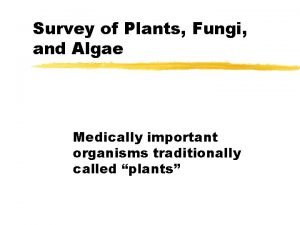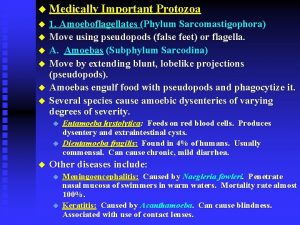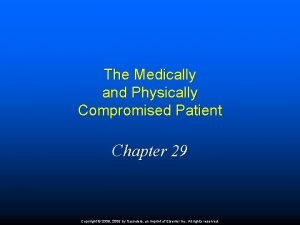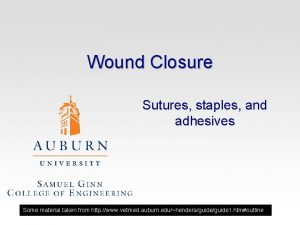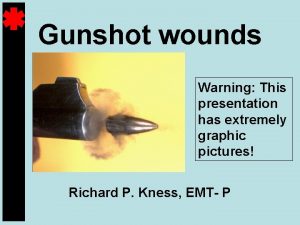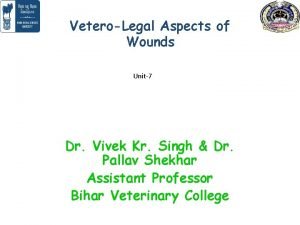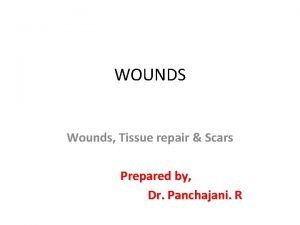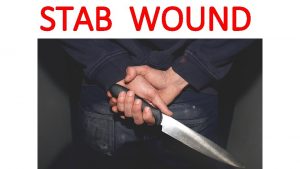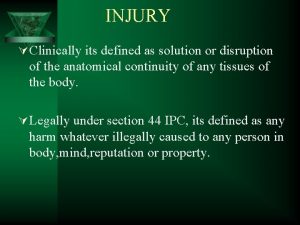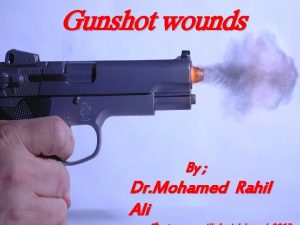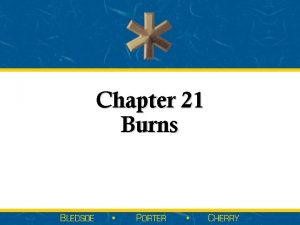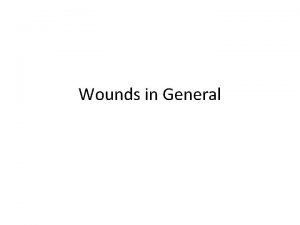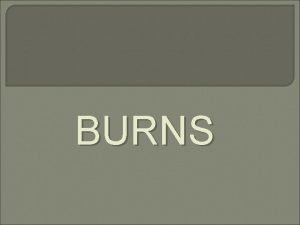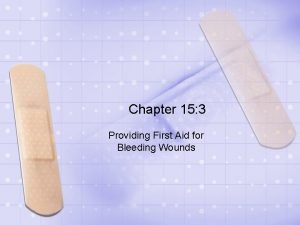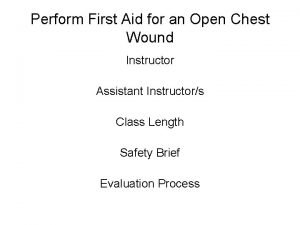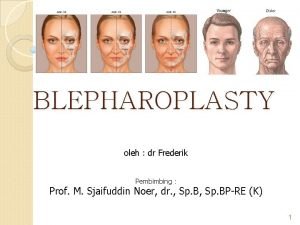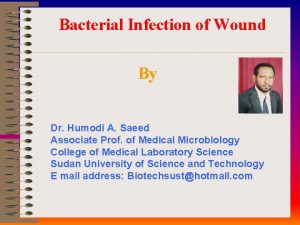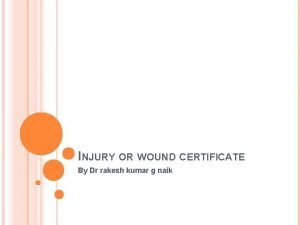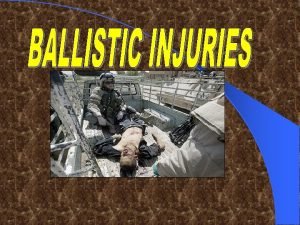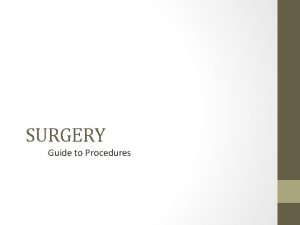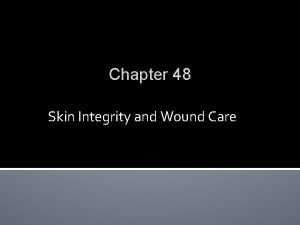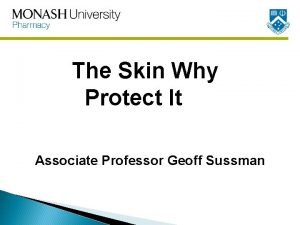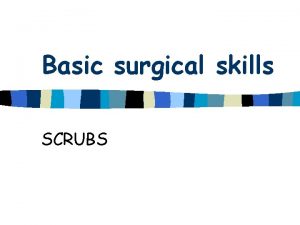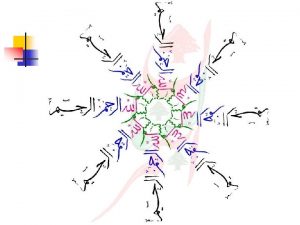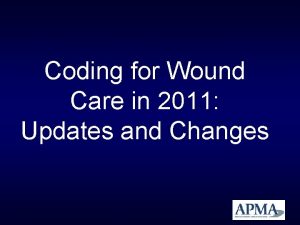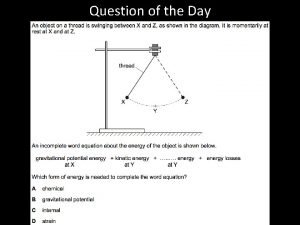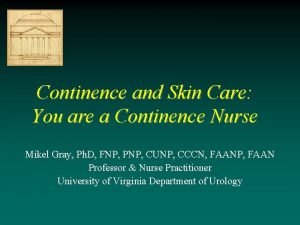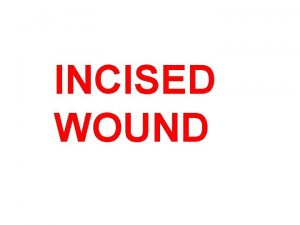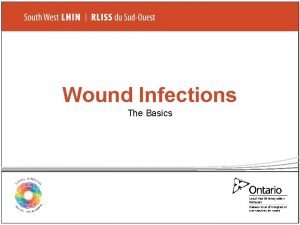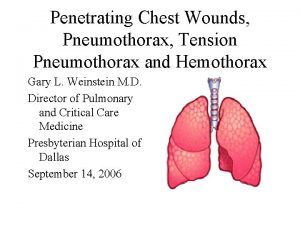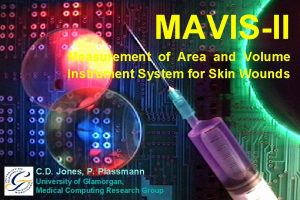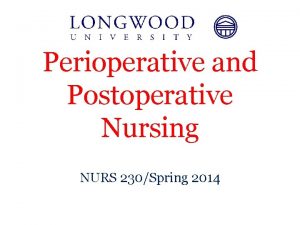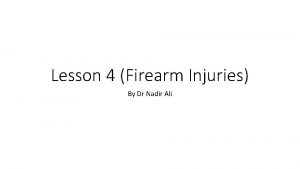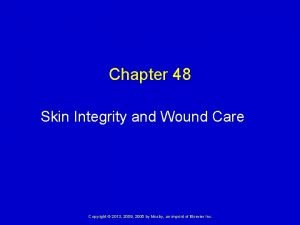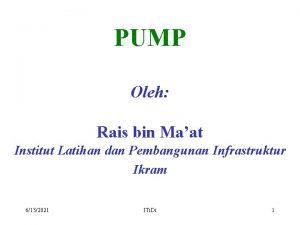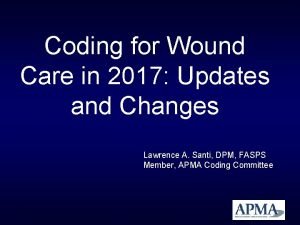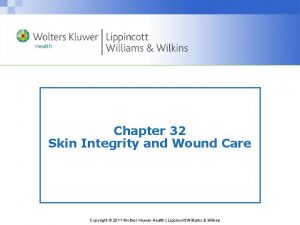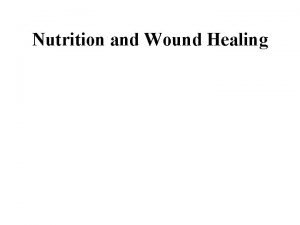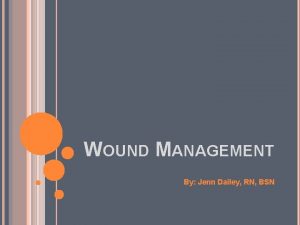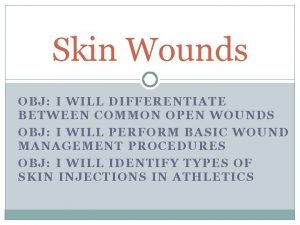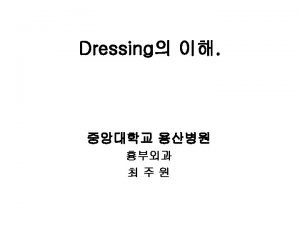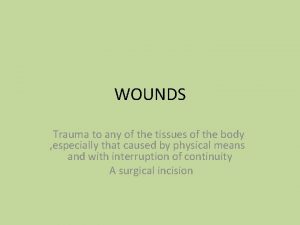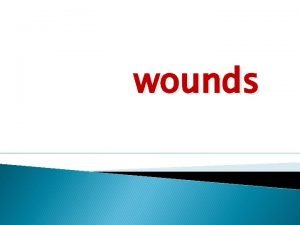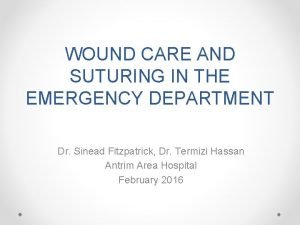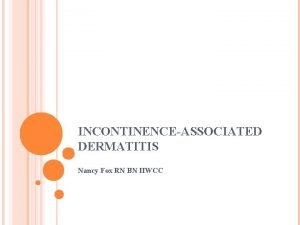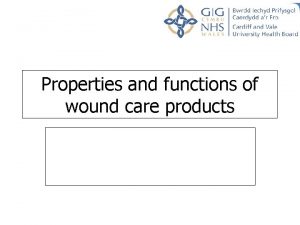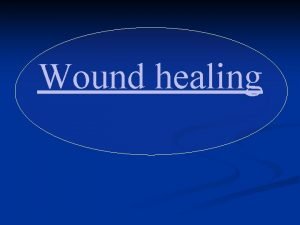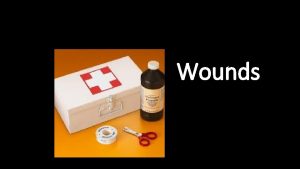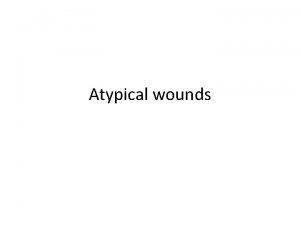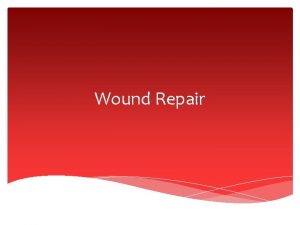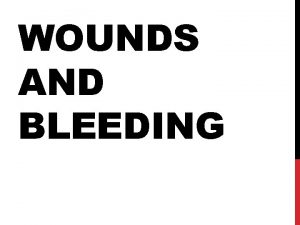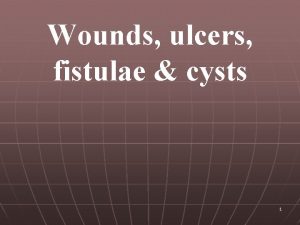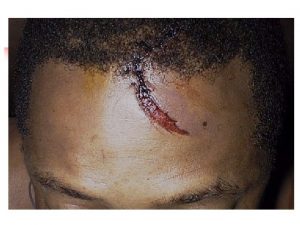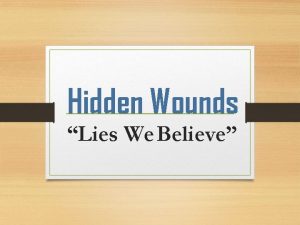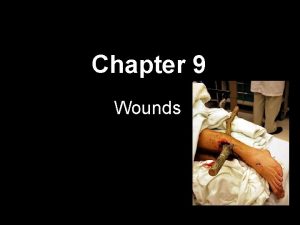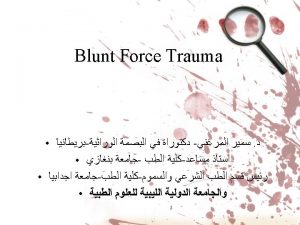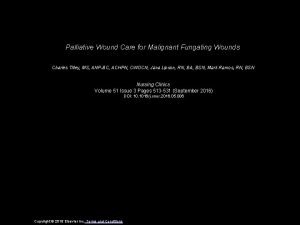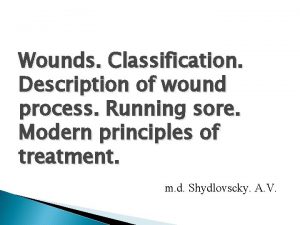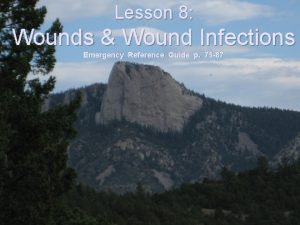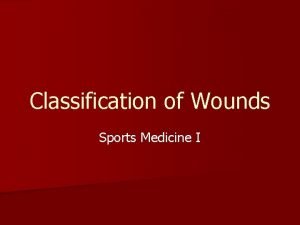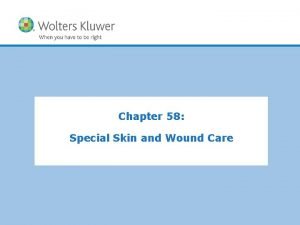WOUNDS WOUNDS Wound is defined medically as disruption























































































- Slides: 87

WOUNDS

WOUNDS Wound is defined medically as disruption of the continuity of the tissues produced by external mechanical force).

The term injury often used u synonymously with wound but can have a wider use, including damage to tissues by heat, cold, chemicals, electricity, radiation, in addition to mechanical force (either blunt force or sharp force







• Skin is elastic and more resistant than underlying tissues, blood vessels more resistant to compression than stretching, while hollow or fluidfilled organs sensitive to compression, bone and joints may transmit force to weak points.

• Injury of the tissues occurs when energy applied by the force exceeds the elastic limits of the tissues depending upon (1) physical factors, like degree of force, area over which the force applied, duration and direction of application (2) Biological factors: mobility of the body part and biomechanical properties of tissue (Different tissues have different strengths and weaknesses).

Classification of Wounds • Simple wounds: which are not serious and heal rapidly in less than 20 days leaving no deformity.

Dangerous wounds: • which are serious injuries that may leave a permanent infirmity or take more than 20 days to heal, (but are not fatal).

Permanent infirmity • Loss of a functioning organ or loss of function of this organ. Thus, loss of a nonfunctioning eye-globe is not considered as a permanent infirmity, it is considered as disfigurement.

Fatal or mortal wounds • which cause death either immediately or within a short time after infliction.

Types of wounds Abrasions Lacerations Bruises Incised Wounds

B- MEDICAL CLASSIFICATION OF WOUNDS: • Wounds are classified into abrasions, contusions (bruises), incised (cut), contused (lacerated), stab wounds and firearm wounds.

Abrasions (Scratch, Graze) • Definition: a portion of the body surface from which the skin or mucous membrane has been removed. It is a superficial injury of the skin not involving the full thickness of the skin (epidermis, and papillary dermis or body lining epithelium) they are 2 types: • 1 - Pressure abrasions due to direct impact as finger nail abrasion. • 2 - Friction abrasions due to tangential impact. They are always occur at the site of application of force.







BRUISES (CONTUSIONS, ECCHYMOSES • Definition: Leakage of blood from ruptured small vessels into surrounding tissues due to trauma, resulting in discolouration may be seen in skin, muscle or any internal organ. Site, shape, size, severity of bruising are very variable.







Medicolegal importance of bruises: • (1) Size of a bruise • (2) Site of a bruise:

(3) Classical Patterns and shapes of Bruising 1) Patterned Intradermal bruise 2) Finger pad bruise (3) Tramline bruising 4) Bite marks:





(5) Counter pressure bruises (6) Black eye (peri-orbital haematoma): may occur due to the following causes: 1 - direct trauma to the orbit. 2 -fracture anterior fossa. 3 -- migration from forehead bruise (7) Punching

• (8) Kicking (or shod foot assault • (9) Medical intervention: can produce bruising in the following cases: • 1 - Sternal and cardiac bruising due to cardiac massage. • 2 - Bruising around needle puncture marks.

(4) Age and colour changes of bruises: • Colour of bruises is due to haemolysis of blood by enzymes and cellular products, it begin at the periphery and progress toword centre if large. Smaller bruises may change colour uniformaly. Pigments, including bilirubin and haemosiderin are released from haemoglobin due to degeneration of red blood cells.

• Antemortem Bruise 1. Accompanied by swelling 2. May be of any size. 3. May show colour changes. 4. Blood is clotted in the tissues. • Post-mortem bruise • No swelling. Always small in size. No colour changes. Only slight clotting or none at all

III. CUT (INCISED) WOUNDS These are caused by drawing a sharp bladed instrument along the surface of the skin (e. g. knife, broken glass, razor, etc. . ).








IV- CONTUSED (LACERATED) WOUNDS • Definition: full thickness tearing of the skin (or other tissue) due to stretching, pinning and crushing of tissues by blunt force trauma. • Typically over bony prominences where tissue is pinned and crushed against underlying bone, e. g. scalp, eyebrow, cheek, skin.












V. STAB WOUNDS • These are caused by thrusting (forcing or piercing) a sharp pointed instruments into the body e. g. a knife, sward, or a dagger




Characters of stab wounds • (1) They are more deep than long. • (2) They have regular cleanly-cut edges. • (3) The shape of these wounds may give an idea about the causative instrument. Thus the sharp knife produces a sharp edged wound with one or two acute angles, depending upon wheather the knife is single or double bladed one. The wound is similar in shape to the cross section of the causal instrument.





Defence wound • The victim do it as an immediate and intensive reaction to save himself. They may be of value in differentiating between suicide and homicide. As small cuts in victim’s palm of hand fingers during his attempt to defend himself by gripping the knife. Abrasions and bruises are also examples of defensive wounds denoting resistence. Absence of defence wounds does not rule out homicidal attack, the victim may be incapable of defence for variety of reasons.





Fabricated wounds • These are self-inflected wounds made to accuse an enemy. Wounds may be also fabricated by a murderer to show that he committed the crime while he is in a condition of self-defence or to change the shape and appearance of otherwounds. Fabricated wounds are characterized by being superficial parallel cuts situated in safe areas within the reach of the hand, without corresponding tear or blood stain in clothes.





COMPLICATIONS OF WOUNDS • I. SHOCK, shock is a severe lowering of the effective blood pressure, due to acute failure of cardiac action, disturbance of nervous control of the heart or from severe blood loss.

• (1) Neurogenic shock (primary shock (2) Haemorrhagic shock (secondary shocku

II. EMBOLISM • a) Pulmonary embolism

III. INFECTION OF THE WOUND Due to contamination of the wound with • streptococci or staphylococci. . etc. resulting in diffuse cellulitis and in severe cases septicaemia or pyaemia.

IV. CRUSH SYNDROME • Traumatic acute tubular necrosis which may be ended by renal faliure, mostly complicate limb trauma in which muscle is necrosed liberating myoglobin. Death occurs at about the end of first week after injury.

Disseminated intravascular (coagulation (DIC is a pathological activation of coagulation mechanisms that happens in response to a variety of disease

 Medically significant algae
Medically significant algae Medically important protozoans
Medically important protozoans Medical mycology ppt
Medical mycology ppt Periodontal management of medically compromised patients
Periodontal management of medically compromised patients Medically compromised definition
Medically compromised definition Pengertian digital disruption
Pengertian digital disruption Orointegratedcoop.com
Orointegratedcoop.com Big bang disruption examples
Big bang disruption examples Accelerated disruption
Accelerated disruption From long disruption remained
From long disruption remained Mis supply chain management
Mis supply chain management 5 points of natural selection
5 points of natural selection Millennial disruption index
Millennial disruption index It is a collection of well-defined objects.
It is a collection of well-defined objects. Staple gun for wounds
Staple gun for wounds Unit 15:8 providing first aid for cold exposure
Unit 15:8 providing first aid for cold exposure Dcap-btls
Dcap-btls Veterolegal meaning
Veterolegal meaning The 5 wounds
The 5 wounds Rank and wakefield classification
Rank and wakefield classification Difference between primary and secondary wound healing
Difference between primary and secondary wound healing 17:3 providing first aid for bleeding and wounds
17:3 providing first aid for bleeding and wounds Concealed puncture wounds
Concealed puncture wounds Cavitation bullet wounds
Cavitation bullet wounds Jackson's theory of thermal burns
Jackson's theory of thermal burns The unfaithful wife archetype examples
The unfaithful wife archetype examples Kinds of wounds with pictures
Kinds of wounds with pictures Jackson's theory of thermal wounds
Jackson's theory of thermal wounds Unit 15:3 providing first aid for bleeding and wounds
Unit 15:3 providing first aid for bleeding and wounds Coil wound heat exchanger
Coil wound heat exchanger Open chest wound first aid
Open chest wound first aid Dehicense
Dehicense Deadly wound healed 1929
Deadly wound healed 1929 Wound dehiscence
Wound dehiscence Humodi
Humodi Ancient simple machines
Ancient simple machines Wound certificate definition
Wound certificate definition Missile wound
Missile wound Prep and drape
Prep and drape Wound tracking software
Wound tracking software Chapter 48 skin integrity and wound care
Chapter 48 skin integrity and wound care Wound care near freedom
Wound care near freedom Medical terms that sound alike
Medical terms that sound alike Geoff sussman wound clinic
Geoff sussman wound clinic Openglobe
Openglobe Types of wound classification
Types of wound classification Factors affecting wound healing ppt
Factors affecting wound healing ppt Persiapan dasar luka
Persiapan dasar luka Utsa wound classification
Utsa wound classification Inclined plane lever
Inclined plane lever Aileen takahashi md torrance ca
Aileen takahashi md torrance ca A moving cart slows slightly as it rolls toward a spring
A moving cart slows slightly as it rolls toward a spring Iad wound
Iad wound Watchman flx dfu
Watchman flx dfu Is sentara non profit
Is sentara non profit Wound care pretest
Wound care pretest Tailing of wound
Tailing of wound 3-phase induction motor problems and solutions
3-phase induction motor problems and solutions Wound types
Wound types Slide is a simple machine
Slide is a simple machine Wound infection continuum
Wound infection continuum Why does beowulf wait allowing grendel
Why does beowulf wait allowing grendel Sucking chest wound
Sucking chest wound Primary union wound healing
Primary union wound healing Types of inflammation
Types of inflammation Wound descriptions with pictures
Wound descriptions with pictures Fire vs ice archetype
Fire vs ice archetype Wind water wound wonder drugs
Wind water wound wonder drugs Blackening and tattooing
Blackening and tattooing Chapter 48 skin integrity and wound care
Chapter 48 skin integrity and wound care Hunger games chapter 6 questions and answers
Hunger games chapter 6 questions and answers Laa closure watchman
Laa closure watchman Wound rotor
Wound rotor Utsa wound classification
Utsa wound classification Copyright
Copyright Wound healing nutrition handout
Wound healing nutrition handout Did jesus die of a broken heart
Did jesus die of a broken heart Local factor affecting wound healing
Local factor affecting wound healing Amerigel wound dressing side effects
Amerigel wound dressing side effects Types of wound
Types of wound Wound type
Wound type An inclined plane wound around a post
An inclined plane wound around a post Tidy and untidy wound
Tidy and untidy wound Type of wound
Type of wound Incised wound
Incised wound Iad wound
Iad wound Exudate
Exudate Deadly wound healed 1929
Deadly wound healed 1929
